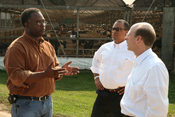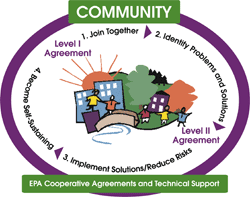Community Action for a Renewed Environment (CARE)
Oneida County CARE Project
Fall 2007

About CARE
Community Action for a Renewed Environment (CARE) is an EPA technical assistance and grant program that offers an innovative way for a community to organize and take action to reduce toxic pollution in the local environment.
Level I, Level II Grants
Awarded at two monetary levels, over two years, CARE grants help communities tackle their problems using a four-step process (see diagram below). Level I grants (up to $100,000) enable communities to progress through the first two steps, which are: 1) build a broad-based partnership and 2) identify a range of environmental problems and solutions. Level II grants (up to $300,000) fund the next two steps, which are: 3) take action to reduce risks and 4) become self-sustaining.

Left to right: Kevin Lewis, Executive Director of Oneida County Soil and Water Conservation; Kent Benjamin, CARE Co-Chair; and Jim Jones, EPA Deputy Assistant Administrator
Oneida County, New York, is a predominantly rural county with a population of approximately 235,000. The cities of Rome and Utica are the largest urban areas with populations of 40,000 and 65,000, respectively. The remainder of the county is made up of agricultural lands, woodlands, and small townships and villages.
Oneida County has a rich history and was once known for its manufacturing and diverse industries. Most of the industries have moved out of the area, but in many cases, remnants of their existence still remain. Facilities and buildings that once housed wire mills, textile mills, and foundries now sit vacant, possibly contaminating surrounding soils and groundwater with waste from former use. Other issues of concern for Oneida County residents are the deteriorating housing stock, aging infrastructure, and the quality of drinking water in rural areas.

Step 1: Joining Together
The CARE Program grant provided funds that enabled the Oneida County Health Department to establish a team of 25 to 30 community members that meets monthly to identify and discuss environmental issues. The membership of the team represents the diversity of the community and targets the area’s wide-ranging environmental health concerns. Oneida County’s governing structure comprises four groups with varying levels of involvement:
- The steering committee provides overall guidance for the project, including developing the agenda for monthly meetings.
- The technical advisory committee reviews technical issues on an as-needed basis.
- The level one group attends monthly community meetings and has voting rights.
- The level two group does not attend monthly meetings, but keeps abreast of project development.
Step 2: Identifying Problems, Solutions
The team met monthly under the direction of a paid facilitator and utilized the Protocol for Assessing Community Excellence in Environmental Health (PACE EH) methodology developed by the National Association of County and City Health Officials to identify and prioritize issues. Initially, team members shared their environmental health concerns, which were recorded on flip charts and subsequently organized into thematic groups. For example, all issues related to open space and future development were grouped as “land use.” After identifying the issues, profiles were developed to allow the team to objectively prioritize them based on significance to the community. In addition, the Oneida County Health Department used a survey to request information from community members who did not attend the monthly meetings to ensure that the views of the broader community were represented. Finally, the team divided the issues into three tiers in order of priority to residents:
- Tier 1 – Lead contaminated housing, solid waste and wastewater management, and vector-borne diseases.
- Tier 2 – Environmentally-related disease, contaminated land, and outdoor and indoor air quality.
- Tier 3 – Drinking water, recreational water, and land use planning.
Step 3: Implementing Solutions, Reducing Risks

Oneida County, New York
To date, most of the team’s efforts have focused on the identification and prioritization of issues. However, the team has also made significant progress toward community outreach and public health education, including:
- The community completed a survey, ranking environmental concerns.
- Sponsoring community forums to showcase efforts and elicit participation.
- Presenting information on the CARE project to community groups, child advocacy groups, and other groups, such as the farming bureau.
Step 4: Becoming Self-Sustaining
The Oneida County Project is a Level I CARE project, and plans to submit a proposal for a Level II grant during fiscal year 2008, with the intention of addressing environmental health issues that were prioritized under Level I. Regardless of whether the county receives federal Level II CARE funding, the diverse membership of the team will enable members to continue to champion some of the environmental issues identified during the prioritization process. Project organizers have tried to ensure maximum representation and sustainability by including representatives from the business sector as well as non-profits and local government agencies.
Partners
- Catholic Charities of Oneida County
- Hamilton College
- Learning Disability Center
- Mohawk Valley Resource Center for Refugees
- New Hartford Animal Hospital
- Oneida County Farm Bureau
- Oneida County Health Department
- Oneida County Planning Department
- Utica College
- Wal-Mart Stores, Inc.
- Many others
For Further Information
Please visit the CARE Web site for more information.
Derval Thomas (thomas.derval@epa.gov), U.S. EPA Region 2 Project Lead
U.S. EPA Region 2
(212) 637-4028
John Dunn (jdunn@ocgov.net), CARE Project Lead
Oneida County Health Department
(315) 798-5064
PDF Versions
- Oneida County CARE Project, Fall 2007 (PDF) (2 pp, 264K, About PDF)
